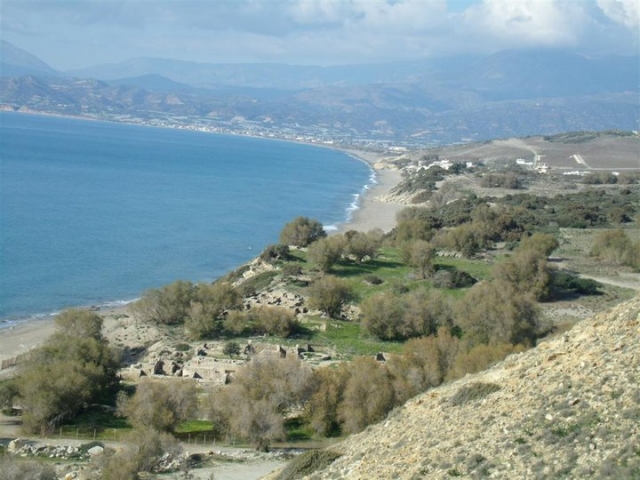Press here.
Places near Xopatera Tower
Agiofarango gorge is one of the most known places of Christian ascetics in the island due to its remote position. According to legends the practicing monks were living in the surrounding caverns eating very little, praying and performing mass in the various rural chapels of this wild area. Close to the church of Agios Antonios another cavern that of goumenospilios (abbot cavern) was probably used an assembly space. Agiofarango Beach Agiofarango Beach Agiofarango Beach Historical evidence shows that Agiofarango was inhabited since the 11th century by monks, a period which is well known for asceticism in the whole area of the Asterousia mountains.Archeological evidence has also brought to light various finds from the Minoan to the early Venetian periods. South of the church of Agios Antonios, a Minoan tholos tomb stands as a reminder of the long history of Agiofarango. The beach of Agiofarango is found at the exit of the homonymous beautiful gorge, at the southern coast of Crete. It is a pebbly beach, well protected from the winds. Agiofarango Agiofarango Beach Agiofarago gorge and Beach
At Kommos, above the famous beach in the south of the prefecture of Heraklion, there is the archaeological site of the Minoan city of Komos. Kommos in Minoan Crete was one of the two ports of the Minoan palace of Phaistos. Matala was the other one.
Excavations of the archaeological site began for the first time in 1976 by a group of Canadian archaeologists, but the existence of Kommos and its connection to the palace of Phaistos was known by Sir Arthur Evans. The finds include the harbor settlement, and public buildings such as shipyards, warehouses, prytaneion, temple and an amphitheater building. One of the most important finds are the ancient olive oil presses, which reveal how developed was the cultivation of olive trees in Minoan Crete.
The archaeological site is not accessible but you can admire the building findings outside the fenced area which is accessible from the road leading to Kommos beach.
The apartments "Acropol" are located in Pitsidia, one of the most beautiful villages of south Crete.
Pitsidia finds itself a couple of kilometres from Matala and Phaistos archaeological site, and about 75 kilometres from Heraklion town.
On the road from Kali Limenes to Lendas (15km), you can find some nice secluded coves and pebble beaches. To reach the settlement you take the road Heraklion city - Mires - Pobia village - Chrisostomos. The distance from Heraklion city is 71 km.
The fertile valley of Platia Peramata is used for growing early vegetables such as tomatoes, cucumbers, peppers, etc., since the temperature here is always high. Characteristic of the warm climate is that the swallows do not leave the area in winter.On the west end of the beach there is a "line" of rocks, that heads towards the small islet of Trafos. This is the old dock of the ancient city Lassea. The rocks were in that place since 1960s, when they were used for the construction of the Oil Tanks of Kali Limenes.
On the island and on the beach, opposite Trafos, you can still see remains of the ancient town of Lasea. The beach continues west of Trafos, creating a separate beach called Segrezo Ryaki that faces west. This beach is very close to the Roman cemetery that has been found here. It is secluded and ideal for nudism, but is also rockier than the main beach. On the west end, there is a spring having water all year round. There is another small pebbly beach 1km east of Chrysostomos, that is called Maha. It is unorganised but there are some rooms and a tavern nearby.
At the edge of the western point of mount Asterousia lies Listaros settlement, the last passage to the mountain and the south coast. Records reveal that the settlement existed since 1577 and was part of Kainouriou province. The statistics of the Barozzi code refer to it as “Listaro”. Despite its long history, settlement continues to “live” although its inhabitants unfortunately gradually abandon it.
Listaros is approximately 200 metes above sea level in this south western area of the prefecture of Heraklio. At this pleasant altitude, just above the intense heat down at sea level, but low enough to enjoy the benefits of the very mild winters on the south side of Crete. Add to this; views over the lower end of the might Messara Plain, across the bay to Agia Galini and out to the Paximadia Islands. All this with a backdrop of the Psiloritis mountains, and you have a truly beautiful part of Crete.
In an island full of climatological and environmental diversities, the area of the Messara plain has a unique character and a lot of diversities to offer itself. It is the largest plain of Crete that extends to the central and southern region of Heraklion County.
It is surrounded from the north by mount Idi (Psiloritis), from east by mount Dikti (Lassithiotika Ori) and from south by mount Asterousia that meet with the Libyan Sea.
While the land of the Messara plain is one of the most fertile ones found on the island, the landscape changes dramatically as the traveler reaches mount Asterousia. A few small ports are the only ones that disrupt the deserted scenery. Monkhood blossomed here from the 7th till the 15th century, something that can be easily detected by the number of monasteries and sketes found in the near gorges and canyons.
Some of the finest examples are the monasteries of Odigitrias, Koudouma and Apezanon, the sketes of Saint Nikita, Martsalo and Agiofarago gorge.DISTANCE FROM LISTAROS:65 klms from the airport and a few less from the port of Heraklion.12 klms from the town of Moires to Matala and Siva0,5 klm from the Komos beach.4,5 klms from Monastery of Odigitrias and another 5-6 klms for the beaches Kaloi Limenes, Agiofarago, Martsalo, Vathi.
To get here you should follow the dirt road that starts from Odigitria Monastery and heads to Lithino Cape (follow the dirt road that turn right after the monastery, while the left heads for Agiofarago gorge). After several kilometers you will see a sign to Martsalo. If you follow the poor dirt track, you will find yourself at the beginning of Martsalo Gorge.
You should leave your car near the entrance to the gorge and continue walking southwards for about 2km.
At the middle of a gorge one can see a church of Saint Mary, nested in a cave, dating from the first Christian years. It is believed that this church was also a catacomb, where Christians were hiding to escape the persecutions of the various occupiers of Crete. Around the church, one can find monk cells carved into the stone and traces of centuries - old buildings..
The village of Pitsidia is located 65 km southwest of Iraklion at an altitude of 80 m a.s.l, just before the magnificent bay of Messara and 2km far from the famous Kommo beach. The village with aproximately 700 inhabitants is the seat of the Pitsidia-Matala community. Pitsidia is the oldest village of the area and is refered (by S. Spanakis) that it was the place where the s oldiers of Nikiforos Fokas, commander of the Byzantine army, settled. The army, famous for its bravery, came from Pisidia of the south Asia Minor, and this is probably the origin of the name Pitsidia. The road from Iraklion is fairly good and passes through the Messara valley. Regular public transportation is available for visiting Pitsidia-Matala. The climate is temperate and it promotes longevity and well-being, as the inhabitants of the village are famous for their longevity.Pitsidia is a quiet village, with a long tradition of hospitality. The spotlessly clean accommodation units, the taverns with their traditional cuisine, the cafes with their aroma of Greek coffee, as well as the cosmopolitan ambiance of the area during the summer months, warranty a memorable stay to all visitors. Visitors are always welcomed at Pitsidia.For more information about Pitsidia, you are invited to visit , or call, the offices of the Community Enterprise of Pitsidia (tel:+30-2892-45340/45720). Pitsidia Pitsidia: Kommo Beach Pitsidia The surrounding landscape is of exceptional natural beauty with archaeological and historical sites which attract a large number of tourists each year. Within the Pitsidia community, 4 km to the southwest, lies the renowned resort of Matala. At a distance of 1500 m. lies the long sandy beach of Kommos and the antiquities of Kommos. Pitsidia Pitsidia Also, the village of Pitsidia can be the starting point for outing and excursions to the archaeological sites in the broader area. Some of the most interesting sites are the ancient mansion of Pitsidia, the archaeological sites of Laggou, Phaistos, Agia Triada and Gortys, the monastery of Odigitria, the gorge of "Agiofarago".







